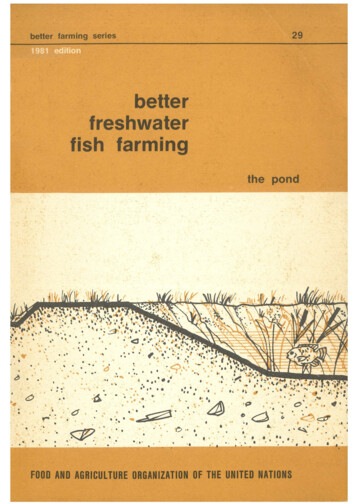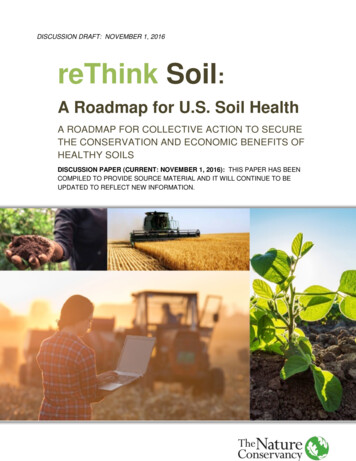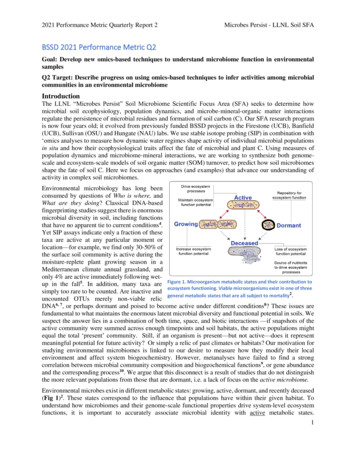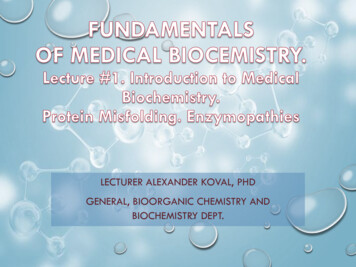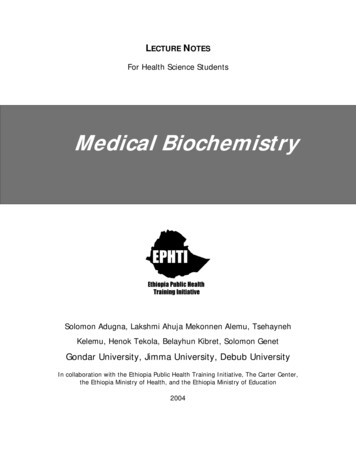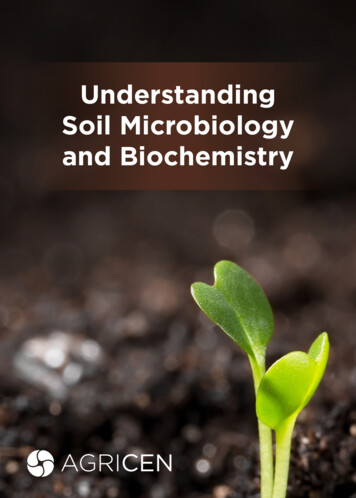
Transcription
UnderstandingSoil Microbiologyand Biochemistry
Understanding the microbiology andbiochemistry of the soil is an important part ofunderstanding how plants grow, but what are soilmicrobiology and soil biochemistry? And howdo they influence plant health and nutrition? Toanswer these questions, let’s turn to the soil.MICROBIOLOGYField of science concerned with microscopic organisms,such as bacteria and fungi. The microbiology of the soildeals with the microscopic living system within the soil.BIOCHEMISTRYField of science concerned with chemical processeswithin or relating to living organisms. The biochemistryof the soil deals with the products/byproducts of theliving system within the soil.1
The Soil Is a Living EnvironmentThe soil is a living environment, full of organisms that influenceplant growth and health.These organisms include visible inhabitants, such as earthworms, as well as a multitude of microorganisms—includingbacteria, fungi, protozoa, nematodes and microarthropods.Together, soil organisms large and small make up about 5% ofthe soil organic matter. Plants—through their growing roots—are also part of this living environment. Many microorganismslive in close proximity to plant roots, an area known as therhizosphere, where there is a rich food source for them in theform of exudates released from the roots.MICROORGANISMSOrganisms that are too small to be viewed without amicroscope, such as bacteria. Also called microbes.SOIL ORGANIC MATTERMatter in the soil that consists of plant and animalresidues at various stages of decomposition, cells andtissues of soil organisms, and substances synthesizedby soil organisms.RHIZOSPHERERegion of the soil immediately around the roots.Microbial activity is very high in this area.EXUDATESSugars, amino acids and other compoundssecreted by plant roots. These provide a food sourcefor microorganisms.2
As soil organisms interact with each other and with the soil,they influence the soil-plant system physically, chemicallyand biochemically. Temperature, moisture, aeration, pH, soilpore spacing, and types of food sources affect how activesoil organisms will be, as well as how many and what types ofspecies will be present.SOIL-PLANT SYSTEMThe interactions between plants and the soil, includingthe physical, chemical, and biological elements of the soil.3
Microorganisms in a Gram of SoilMicrobial GroupNumbers in a Gram of SoilBacteria100 million – 1 billionFungi100 thousand – 1 millionAlgae &Cyanobacteria1 thousand – 1 millionProtozoa1 thousand – 100 thousandNematodes 100Source: Sylvia D, Fuhrmann J, Hartel P, Zuberer D. Principles and Applications ofSoil Microbiology. 1997. Prentice Hall: Upper Saddle River, NJ.Activity (in Cropland)Seasonal Bacterial and Fungal nthMicrobial activity significantly diminishes at temperatures below 50 F.Source: Tugel A, Lewandowski A, Happe-vonArb D, eds. Soil Biology Primer. Rev.ed. 2000. Ankeny, Iowa: Soil and Water Conservation Society.4
Key beneficial roles of soil microorganisms: Decompose organic materials Recycle nutrients in the soil by converting organicmaterials into forms plants and other soil organismscan use (mineralization) Generate oxygen in the atmosphere, which is importantfor plant respiration “Fix” nitrogen from the atmosphere by converting it toammonium (nitrogen fixation), making it available to plants Retain nutrients such as nitrogen or carbon in their cells,keeping them in the root zone (immobilization) Feed on each other, releasing immobilized nutrientsin their excretions (e.g., protozoa and nematodes thatexcrete excess nitrogen when they eat bacteria and fungi) Give plant roots access to soil nutrients by transportingthem to the plant (i.e., the mycorrhizal fungi that colonizeplant roots) Bind soil particles into aggregates, helping with soilstructure and water dynamics Help to suppress plant diseases by competing with orfeeding on pathogens Degrade soil pollutants5
Soil Microorganisms inPlant Health and NutritionMicroorganisms play many beneficial roles in plant health andnutrition. Through their activities, they help plants extract thenutrients they need for growth and functioning. They also affectthe soil structure, influencing water dynamics on, in and throughthe soil. In addition, although some microorganisms can causedisease, many more help protect the plant from pathogens.MINERALIZATIONConversion of organic forms of nutrients intoinorganic forms that plants can use. As soil organismsmetabolize nutrients, transforming them into inorganicforms that are then excreted, the nutrients aremineralized and are available for plant use.NITROGEN FIXATIONConversion of atmospheric nitrogen to ammonium,a plant-available form of nitrogen.IMMOBILIZATION“Storage” of nutrients within soil organisms as they liveand grow. When soil organisms consume soil nutrients,the nutrients are immobilized and are not available forplant use.6
Biochemical Interactionsin the Soil-Plant SystemMany of the interactions in the soil-plant system—whetheramong the microorganisms and between microorganisms andplants—occur through biochemical signaling, particularly inthe rhizosphere.Biochemical compounds produced by microorganisms andby plant roots are the tools by which biochemical signals arecreated and transmitted. They are the tools that microbesneed to function in the soil, and determine their ability toprocess nutrients (including the nutrients in fertilizers),stimulate root growth and perform other functions critical toplant health and nutrition.With up to 50 billion microbes in a teaspoon of soil, imaginethe number of biochemical compounds that are producedduring their lifecycles. Each of these microorganisms may bethe source of unique biochemical compounds that affect avariety of soil, plant and microbial community functions.BIOCHEMICAL SIGNALINGInteractions and communication within and amongorganisms through the biochemical compoundsproduced by those organisms.BIOCHEMICAL COMPOUNDSChemical compounds that are part of the makeup of aliving cell or produced by or in an organism; hormones,amino acids, organic acids, sugars and enzymes areexamples of biochemical compounds.7
Biochemistry: The Backbone of SoilMicrobial FunctioningBiochemical compounds produced by soil microorganismsinclude: Enzymes that break down organic matter, transform N forenergy and perform many other functions Proteins that signal changes in microbe response Chelators that mobilize nutrients Antibiotics that reduce competition Compounds that induce plant rooting, changephysiological functions, induce immune responses andincrease salt toleranceENZYMESMolecules that speed up chemical reactions.CHELATORSMolecules that bind tightly to metal ions, formingcomplexes with them.8
Spotlight on N-P-KWhen it comes to the “big three” macronutrients that plantsneed—nitrogen, phosphorus and potassium—why do soilmicrobiology and soil biochemistry matter? Nitrogen: In the soil profile, the great majority ofnitrogen ( 90%) is typically in an organic form (e.g., incrop residues, manures, litters, composts) and needs tobe converted into inorganic forms—that is, ammonium(NH4 ) or nitrate (NO3-)—that plants can take up and use.This transformation is called the mineralization process.Biochemical compounds produced by microbes in the soilprofile mineralize organic nitrogen into an inorganic formthat plants can use. Phosphorus: A good portion (25%-65%) of phosphorusin the soil profile can be tied up in organic matter.Biochemical compounds help to dissolve, solubilize andmineralize soil phosphorus, transforming it into inorganicforms (H2PO4- or HPO42-) that are available for plant use. In the soil, potassium quickly gets locked in between soillayers, becoming unavailable to the plant. Unlike nitrogenor phosphorus, where mineralization or solubilization isnecessary, potassium remains in the K form in both the soiland the plant—but requires a release from the soil profile.Biochemical compounds produced by microorganismshelp to improve the soil structure and a plant’s ability totake up potassium.9
Soil microbes and the biochemical compoundsthey make play a major role in nutrient releaseand nutrient use efficiency. By taking care ofsoil health—including by using products thatenhance the microbial and biochemical activityin the soil—growers can capture the power of soilmicrobiology and biochemistry and improve theproductivity of their growing operations.10
Based on Nature. Built on Science.Agricen5601 Granite ParkwaySuite 740Plano, TX 75054Phone:Fax:Email:(800) 787-3724(940) m/Agricentwitter.com/AgricenCo
microbiology and soil biochemistry matter? Nitrogen: In the soil profile, the great majority of nitrogen ( 90%) is typically in an organic form (e.g., in crop residues, manures, litters, composts) and needs to be converted into inorganic forms—that is, ammonium (NH 4 ) or nitrate (NO 3-)—that plants can take up and use.




